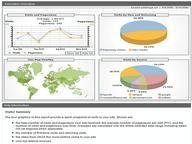Quiz Answer Key and Fun Facts
1. Craps is played with two dice. If you roll a 7 or an 11 on your first roll, you win. What are the chances that you win on your first roll?
2. In Craps, if you roll a 2, 3, or 12 on your opening roll you lose. What are the odds of rolling one of these numbers?
3. In Craps, if your first roll is a 4, 5, 6, 8, 9, or 10, that number becomes your point. You roll the dice again and need to roll your point again prior to rolling a 7. If you throw a number other than 7 or your point, it doesn't count and you roll again. What are the odds that you roll one of these numbers and then roll your point prior to rolling a 7?
4. While playing Yahtzee, what are the odds that, on your first throw for a turn, all five dice come up with the same number?
5. What are the odds of rolling a large straight (1-2-3-4-5 or 2-3-4-5-6) when you roll all five dice in Yahtzee?
6. Playing Yahtzee, you are trying to get three of a kind. After two rolls five dice show 1-3-5-6-6. You pick up the three dice that aren't 6's and reroll them. What are the odds that you'll have at least three of a kind after your third and final roll? (Be careful)
7. It's your last turn in a Yahtzee game and the only open score is three of a kind. So your primary goal is to get three of a kind of some sort. After two rolls, you have 5-5-4-4-3. On your third roll, it is a better strategy to pick up the 4-4-3 and roll three dice rather than just pick up the 3 and roll one die.
8. When a player attacks in Risk, he can roll one, two, or three dice depending on circumstances. The defender can roll one or two dice, again depending on circumstances. After both players have rolled, the highest die roll for each is compared with the defender winning in case of a tie. The losing player loses a piece. If both players have rolled at least two dice, the second highest for each is compared. Again, the defender wins a tie and the losing player loses a piece. If both players roll two dice, what are the chances that the defender loses two pieces?
9. You're playing Monopoly with one red die and one blue. You are sitting in the Just Visiting section of the Jail square. How many different combinations of rolls will allow you to end your turn on Free Parking which is ten squares away? For the purposes of this question, a 3 with the red die and a 2 with the blue die is a different combination than a blue 2 and a red 3. Remember that if you throw doubles you move the amount of the doubles and then have to throw again unless it is your third throw in which case you go to Jail.
10. On your first turn in Monopoly, what are the odds that you will throw doubles three times in a row and be sent directly to jail (assuming the top card in the Chance or Community Chest pile does not send you to jail)?
Source: Author
andymuenz
This quiz was reviewed by FunTrivia editor
rossian before going online.
Any errors found in FunTrivia content are routinely corrected through our feedback system.

